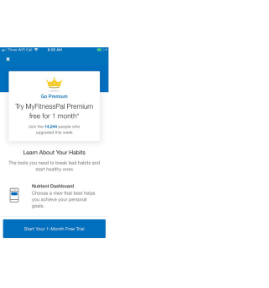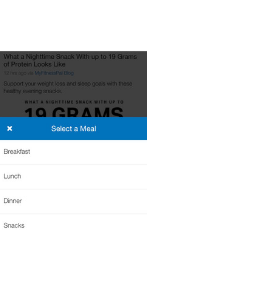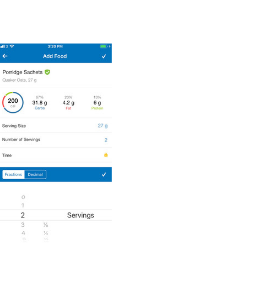So you have your macros. Now what?
It’s all well and good knowing how much protein, carbohydrate and fat you need, but it’s not much use if you don’t know how to track them.
Seasoned flexible dieters are quick to say how easy it is to track, and how it takes them just minutes every day. And truth is, in time, it does get to that stage. But when you’re starting out, it can take a little more time to get to grips with, and can often seem frustrating and confusing.
The main reason people stop flexible dieting, and go back to rules-based diets, (or go completely off the rails,) is because they get annoyed with having to track. That’s a shame, because we know that flexible dieting is the most sustainable, evidence-based way to eat, and it needn’t be overly difficult or time-consuming.
Using this guide, anyone should be able to go from tracking newbie to tracking superstar in no time at all.
Step 1: Downloading MFP
Go to the app store on your phone and search for ‘MyFitnessPal’ then download.

Once the app’s downloaded, it’ll get you to register with an email address or your Facebook account, than ask you to fill in some basic information.

While you do need to fill this in so that you move ahead and can start tracking, just note that the numbers the app generates for you are not the numbers you should use. If it’s easier, you can even just put in random numbers for weight, height, desired loss each week, and so on.
If you’ve already calculated your macros some other way, I want you to use these, and ignore whatever targets MFP gives you.

Step 2: Pay to Play?
There are two versions of MyFitnessPal (MFP) - The free version, and premium, which costs $9.99 per month or $49 for the year, depending on what country you’re in.
I wanted to address this upfront, before you crack out your credit card, as upon signing in for the first time, you’ll be given the option to try premium for a month.

While the premium version does have some extra features, it’s really not necessary.
It allows you to set your own macro targets, get a food analysis, food timestamps, and monitor the pie chart in grams, rather than percentages, which you may find useful, but seeing as all you have to do is remember 3 numbers (your protein, carb and fat goals,) and it’s unlikely you’ll ever refer to the pie chart, the premium version is largely unnecessary.
If you do have a really bad memory, and can’t remember your numbers, just save them in the notes of your phone, or even go old fashioned with a pen and paper.
The only downside with the free version is that you may get the odd banner ad pop up, but again, it’s not exactly a big issue, and not worth paying that much to remove.
Step 3: Logging Your Food
On the home screen, if you hit the big blue plus sign at the bottom in the centre, it brings up 5 options to track -
- Status
- Water
- Food
- Exercise
- Weight

Over time, you may find use for status, water, exercise and weight, but much like many of MFP’s features, you really needn’t concern yourself with these too much. Our big concern is food. Hit that, and you’ll be given the option of tracking breakfast, lunch, dinner or snacks.

Select which meal you’re tracking, and then enter the desired amounts of each food.
Over time, you’ll most likely be able to track retrospectively, and log meals after you’ve eaten them, while still being on-track for your daily totals. But for the first few weeks of tracking, or if you’re on lower macros, it’s highly advised to track everything before you eat it.
span class="Apple-converted-space">
Step 4: Finding Your Foods
You have 4 ways to search for and add foods.
1. By searching the MFP database:

2. By entering the food yourself.

3. By quick-adding the calories and macros. (Macro options only available with the premium version)

4. Using the barcode scanner.

Step 5: Adding Them In
Once you’ve found the food you want to add, select the amount you’re having, then click the tick to add it to the meal. If you’re adding a pre-recorded food item, it comes up with the default serving size. You can use this if you want (changing to fit how much you had,) or, if you’re not too good with working in fractions, most foods give you the option of logging the food in grams or ounces as well.

This is where your food scale is going to come in handy. While, in time, you’ll likely be able to get away with guesstimating some foods, it’s imperative you track in the beginning, to get used to serving sizes. Most people grossly underestimate how much they’re eating, especially when it comes to things like peanut butter, cereals, rice, oils, and salad dressings or sauces, so use your scale.
People often ask if they need to track things like green vegetables.
My response would be that it’s not a bad idea to. At least at first. Again, the more you get into tracking, the more you’ll just be able to measure low-calorie foods like veggies and some fruits as ‘a serving’ (or 2-3 servings if you’re having more,) and you’ll probably be pretty close in terms of calories and macros. But to start with, it’s wise to weigh everything for your first few days, to get an idea of what constitutes a portion for foods you eat regularly.
Once you’ve added all your foods to a meal, you’ll be able to see the calorie totals for that meal, and calories and macros for the day so far.

(Left picture shows calories from individual breakfast foods, as well as a total number of calories consumed (the 653 number) while the right picture shows the macro breakdown.)
When it comes to viewing macros for the whole day, you only need to look at the nutrients tab, and we’re only really focusing on the total numbers for protein, carbohydrates and fats, (and possibly fiber.) Everything else you can ignore.
The macros tab gives you a breakdown of macro percentages, which we’re not concerned with, while the calories tab shows the percentage of calories consumed at each meal. Studying these is just overcomplicating things when you don’t need to.
Go through the rest of your day, logging what you’re going to eat for each meal or snack.
You may want to check back on the nutrients tab after each meal to make sure you’re not going over (or too far under) any one macro. But by the end of the day, you should have something that looks like this:

Step 6: Consistency
You don’t need to hit each number on the dot. A little leeway is fine, provided you’re not consistently under or consistently over by more than 5-10 grams on each macro.
Let’s say I was shooting for 200 grams of protein, 280 grams of carbs, and 85 grams of fat, the above day would be pretty good. In fact, it’s almost perfect. There’s no need to stress over being a few grams out on anything.
Once again, ignore any MFP data that says you’ve missed your goals. Remember, we’re sticking to the macros you’ve already worked out, not the ones generated by the app.
Step 7: Missing Foods/ Eating Out
As good as MFP is, there’ll be times when it doesn’t have the food you’re eating, especially if you’re going to an independent restaurant, or eating at a friend’s house.
The key here is not to stress. If you’re within 4 or 5 weeks of a show or shoot, it’s not ideal, but then if you’re this close to a big event, you’re probably not going to be eating out much anyway. Simply make a best educated guess as to what it contains macro-wise, or find something similar.
For example, if you go somewhere like Chipotle, you’re not going to ask the server to break out the digital scale, and there’s no way you’ll be able to estimate extremely accurately, so just pick something that looks sensible from the MFP database:

Step 8: Balancing Your Macros
The more you track, the easier it is to be accurate. The vast majority of people tend to eat similar foods on a daily basis anyway, so chances are, you’ll fall into some kind of routine, and may not need to track until lunchtime, or can even double check your numbers at the end of the day, and just fill in any missing with a last random meal or a few snacks.
It’s important not to stress too much though.
MFP is an extremely useful tool, and certainly makes it easier to track than the old school pen and paper or Excel spreadsheet methods, but don’t obsess over it. Be consistently accurate, not consistently perfect.
If you do find you go over on something, you can either reduce other macros that day to compensate while still hitting your calorie target. (Carbs and protein contain 4 calories per gram each, fat contains 9 calories per gram.) Or you can just eat a little less the next day.
Alternatively, if you’re just starting out, it’s really not a big issue to simply forget about it, and try to be more accurate the next day.
The only thing to pay attention to is if you consistently go over on a macro. Some people find they do this with fat, if they’re used to using full-fat dairy products, cooking with oils, liberally use salad dressings, etc. If this is the case, you could either switch to reduced-fat versions, or lower your daily carb target so you can increase your fat target, while keeping your daily calorie target the same.
Any Other Business?
Not especially. My Fitness Pal has some cool tools and features, but you really don’t need them.
If you find it helpful, you can track your weight, and your activity, but if the app tells you to change your macro targets because you’re more active, ignore this advice.
You’ll have already calculated your macros based on an idea of your typical daily activity levels and calorie expenditure anyway, so you don’t need to ‘eat back’ any calories burned from exercise.
Just one final reminder - Use the app solely for tracking, and only worry about the one main nutrients tab on the daily totals. You’ve already got your macros, and MFP isn’t designed to set them up for you, so don’t be swayed into making any changes, or worrying about things like macro percentages.
Hit your numbers within 5-10 grams, and you’ll be just fine.